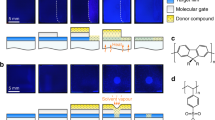Abstract
If the rich functionality of organic molecules is to be exploited in devices such as light-emitting diodes or field-effect transistors1,2,3,4,5,6,7, interface properties of organic materials with various (metallic and insulating) substrates must be tailored carefully7,8,9,10. In many cases, this calls for well-ordered interfaces. Organic epitaxy11,12,13—that is, the growth of molecular films with a commensurate structural relationship to their crystalline substrates—relies on successful recognition of preferred epitaxial sites. For some large π-conjugated molecules (‘molecular platelets’) this works surprisingly well14,15, even if the substrate exhibits no template structure into which the molecules can lock13,15,16. Here we present an explanation for site recognition in non-templated organic epitaxy, and thus resolve a long-standing puzzle11. We propose that this form of site recognition relies on the existence of a local molecular reaction centre in the extended π-electron system of the molecule. Its activity can be controlled by appropriate side groups and—in a certain regime—may also be probed by molecularly sensitized scanning tunnelling microscopy. Our results open the possibility of engineering epitaxial interfaces, as well as other interfacial nanostructures for which specific site recognition is essential.



Similar content being viewed by others
References
Dodabalapur, A. Organic light emitting diodes. Solid State Commun. 102, 259–267 (1997)
Horowitz, G. Organic field-effect transistors. Adv. Mater. 10, 365–377 (1998)
Dimitrakopoulos, C. D. & Malenfant, P. R. L. Organic thin film transistors for large area electronics. Adv. Mater. 14, 99–117 (2002)
Katz, H. E. et al. A soluble and air-stable organic semiconductor with high electron mobility. Nature 404, 478–481 (2000)
Schoonfeld, W. A. et al. Coloumb-blockade transport in single-crystal organic thin-film transistors. Nature 404, 977–980 (2000)
Crone, B. et al. Large-scale complementary integrated circuits based on organic transistors. Nature 403, 521–523 (2000)
Dimitrakopoulos, C. D. et al. Low voltage organic transistors on plastic comprising high-dielectric constant gate insulators. Science 283, 822–824 (1999)
Horowitz, G. et al. Role of semiconductor/insulator interface in the characteristics of π-conjugated-oligomer-based thin film transistors. Synth. Metals 51, 419–424 (1992)
Hill, I. G. et al. Organic semiconductor interfaces: electronic structure and transport properties. Appl. Surf. Sci. 166, 354–362 (2000)
Meyer zu Heringdorf, F. J. et al. Growth dynamics of pentacene films. Nature 412 (2001), 517–520
Forrest, S. R. Ultrathin organic films grown by molecular beam deposition and related techniques. Chem. Rev. 97, 1793–1896 (1997)
Hillier, A. C. & Ward, M. D. Epitaxial interactions between molecular overlayers and ordered substrates. Phys. Rev. B 54, 14037–14051 (1996)
Umbach, E. et al. Surface architecture with large organic molecules: Interface order and epitaxy. Surf. Sci. 402–404, 20–31 (1998)
Chen, Q. et al. Epitaxy of a crystalline organic semiconductor: Perylene/Cu(110). Chem. Mater. 14, 743–749 (2002)
Fink, R. et al. Substrate-dependent lateral order in naphthalene-tetracarboxylic-dianhydride monolayers. Phys. Rev. B 60, 2818–2826 (1999)
Soukopp, A. et al. Superstructure formation of large organic adsorbates on a metal surface: A systematic approach using oligothiophenes on Ag(111). Phys. Rev. B 58, 13882–13894 (1998)
Tada, H. et al. Structural analysis of lead phthalocyanine ultrathin films grown on cleaved faces of alkali halides by reflection high energy electron diffraction. Surf. Sci. 268, 387–396 (1992)
Zhang, Y. & Forrest, S. R. Mechanisms of quasiepitaxial ordering at organic molecular thin film interfaces. Phys. Rev. Lett. 71, 2765–2768 (1993)
Forrest, S. R. et al. Ultrahigh-vacuum quasiepitaxial growth of model van der Waals thin films II. Experiment. Phys. Rev. B 49, 11309–11321 (1994)
Hirose, Y. et al. Ordered, quasi-epitaxial growth of organic thin film on Se-passivated GaAs(100). Appl. Phys. Lett. 66, 944–946 (1995)
Schmitz-Huebsch, T. et al. Epitaxial growth of 3,4,9,10-perylenetetracarboxylic dianhydride on Au(111): A STM and RHEED study. Phys. Rev. B 55, 7972–7976 (1997)
Hirose, Y. et al. Quasiepitaxial growth of the organic molecular semiconductor 3,4,9,10-perylenetetracarboxylic dianhydride. Phys. Rev. B 52, 14040–14047 (1995)
Forrest, S. R. et al. Organic-on-organic semiconductor contact barrier diodes. II. Dependence on organic film and metal contact properties. J. Appl. Phys. 56 543–551 (1984),
Möbus, M. et al. Structure of perylene-tetracarboxylic-dianhydride thin films on alkali halide crystal substrates. J. Cryst. Growth 116, 495–504 (1992)
Taborski, J. et al. NEXAFS investigations on ordered adsorbate layers of large aromatic molecules. J. Electr. Spec. Rel. Phenom. 75, 129–147 (1995)
Tautz, F. S. et al. Strong electron-phonon-coupling at a metal/organic interface: PTCDA/Ag(111). Phys. Rev. B 65, 125405 (2002)
Tautz, F. S. et al. A comparison of the chemisorption behaviour of PTCDA on different Ag surfaces. Surf. Sci. 502–503, 176–184 (2002)
Frisch, M. et al. Gaussian 98, Rev. A6, (1998) (Gaussian, Inc., Pittsburgh)
Böhringer, M. et al. Scanning tunneling microscope-induced molecular motion and its effect on the image formation. Surf. Sci. 408, 72–85 (1998)
Wagner, V. Raman analysis of ordered organic monolayers on metal surfaces. Phys. Status Solidi A 188, 1297–1305 (2001)
Acknowledgements
We thank V. Shklover and E. Umbach of the University of Würzburg for making output data of the quantum chemical calculations available to us, and for discussions. The work was financially supported by the Deutsche Forschungsgemeinschaft.
Author information
Authors and Affiliations
Corresponding author
Ethics declarations
Competing interests
The authors declare that they have no competing financial interests.
Rights and permissions
About this article
Cite this article
Eremtchenko, M., Schaefer, J. & Tautz, F. Understanding and tuning the epitaxy of large aromatic adsorbates by molecular design. Nature 425, 602–605 (2003). https://doi.org/10.1038/nature01901
Received:
Accepted:
Issue Date:
DOI: https://doi.org/10.1038/nature01901
- Springer Nature Limited
This article is cited by
-
A standing molecule as a single-electron field emitter
Nature (2018)
-
Interfacial phenomena between conjugated organic molecules and noble metals
Korean Journal of Chemical Engineering (2017)
-
Electrochemical gene sensor for Mycoplasma pneumoniae DNA using dual signal amplification via a Pt@Pd nanowire and horse radish peroxidase
Microchimica Acta (2016)
-
Molecular distortion and charge transfer effects in ZnPc/Cu(111)
Scientific Reports (2013)
-
Angular dependent NEXAFS study of the molecular orientation of PTCDA multilayers on Au (111) surface
Chinese Science Bulletin (2011)





